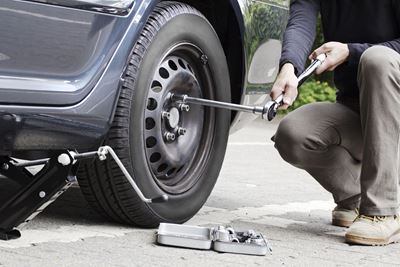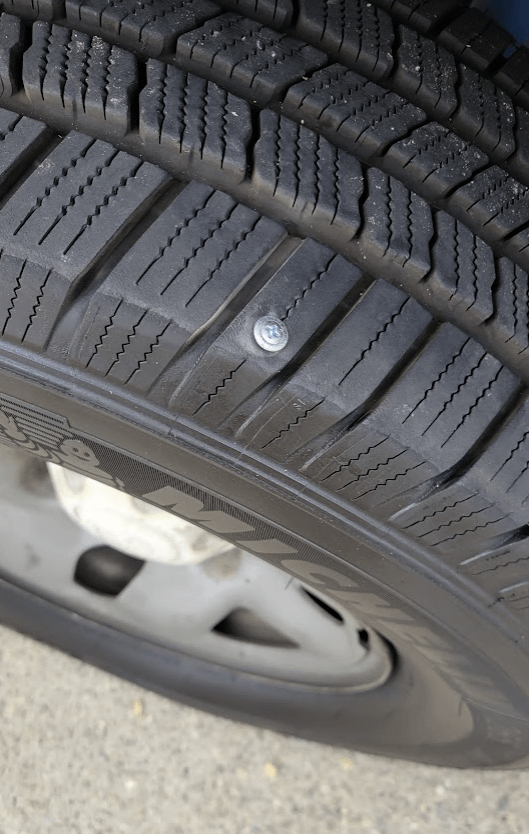Yes, you can replace just one tire. However, it’s best to replace at least two tires for safety and performance.
Replacing just one tire is sometimes necessary, especially when the damage is isolated. It’s crucial to ensure the new tire matches the existing ones in size, type, and tread pattern. Uneven tires can cause handling issues and uneven wear. Rotating the tires regularly can help maintain balance.
Always consult your vehicle’s manual and a professional mechanic for the best advice. Proper tire maintenance ensures safety and longevity. Investing in quality tires and timely replacements can save you money and trouble in the long run. Make informed decisions to keep your vehicle running smoothly.

The Risks Of Replacing Only One Tire
Replacing just one tire might seem like a cost-effective solution. But, it can lead to several significant risks. Understanding these risks can help you make a better decision for your vehicle’s safety and performance.
Compromised Handling
Using one new tire with older tires can affect your car’s handling. The tread depth between new and old tires varies. This can lead to uneven traction on the road. Uneven traction can cause your car to pull to one side. This affects your ability to steer and brake effectively.
Also, modern vehicles often have advanced safety systems. These systems rely on uniform tire traction. Replacing only one tire can confuse these systems. This can lead to compromised performance and safety.
Uneven Wear And Tear
Replacing only one tire can cause uneven wear and tear. New tires have deeper treads compared to old tires. This mismatch causes the new tire to wear out faster. The tread on the new tire will try to match the older tires. This results in irregular wear patterns.
Uneven wear also affects your car’s suspension system. The suspension system works best with balanced tires. Uneven tires can lead to more stress on your suspension components. This can result in more frequent and costly repairs.
Below is a table showing the differences between new and old tires:
| Tire Condition | Tread Depth | Traction |
|---|---|---|
| New Tire | 10/32 inches | High |
| Old Tire | 4/32 inches | Low |
Always consider the risks before deciding to replace just one tire. Your safety and your vehicle’s performance should always come first.

When Is It Acceptable To Replace A Single Tire?
Replacing a single tire can be tricky. It’s important to know when it’s acceptable. Safety and performance are key factors. Let’s explore the scenarios where replacing just one tire is okay.
New Tires With Minimal Wear
If your tires are new, replacing one tire is often fine. New tires have similar tread depth. This ensures balanced traction and performance. Check if the tire has less than 2/32 inch wear. If it does, a single tire replacement is usually safe.
| Condition | Action |
|---|---|
| New tire with less than 2/32 inch wear | Replace one tire |
| New tire with more than 2/32 inch wear | Consider replacing all tires |
Matching The Remaining Tread Depth
Tread depth matching is crucial. Uneven tread depths affect handling and safety. Ensure the new tire’s tread depth matches the remaining tires. Use a tread depth gauge to measure each tire. Aim for a depth difference of less than 2/32 inch.
- Measure tread depth with a gauge
- Compare the new tire’s depth with the old ones
- Ensure a depth difference of less than 2/32 inch
Failing to match tread depths can lead to issues. Your vehicle might pull to one side. It can also cause premature wear on the new tire. Always prioritize safety and performance.
Understanding Tire Pairing
Many drivers wonder, can you replace just one tire? This is a common question. The answer is not straightforward. Understanding tire pairing is key. This means knowing how tires work together. Different axles and drive systems have unique needs.
Front And Rear Axle Considerations
Front and rear axles have different roles. The front axle steers the car. The rear axle helps with stability. Replacing one tire can cause problems. Uneven tires may lead to poor handling.
Here are some key points:
- New tires have more tread than old ones.
- Mismatched tires can affect braking distance.
- Uneven tires cause more wear and tear.
All-wheel Drive Dynamics
All-wheel drive (AWD) vehicles are different. They need all tires to be similar. This ensures even power distribution. Replacing just one tire can cause damage. The drivetrain may work harder. This can lead to costly repairs.
Important points for AWD:
- Even tire wear ensures smooth driving.
- Mismatched tires can confuse the AWD system.
- Always consult the vehicle manual for tire replacement guidelines.
Knowing the basics of tire pairing helps in making the right decision. Always consider front and rear axle roles. Remember the unique needs of AWD systems. This ensures a safer and smoother drive.
Cost Implications Of Single Vs. Multiple Tire Replacement
Replacing a tire can be costly. Understanding the cost implications of replacing one tire versus multiple tires is crucial. It can save you money in both the short and long term.
Short-term Savings
Replacing just one tire offers immediate short-term savings. Here’s a comparison:
| Option | Cost |
|---|---|
| Single Tire Replacement | $100 – $200 |
| Multiple Tire Replacement | $400 – $800 |
Replacing one tire costs less upfront. This can be a quick fix if you have budget constraints. But, there are other factors to consider.
Long-term Costs
While replacing one tire saves money now, long-term costs may increase. Here are a few reasons:
- Uneven Tire Wear: New and old tires wear unevenly. This can lead to more frequent replacements.
- Alignment Issues: Different tire treads can affect your car’s alignment. This might require additional services.
- Performance: Mixed tire conditions can impact your car’s performance and safety.
Replacing multiple tires at once can balance wear and tear. It ensures consistent performance and can save money over time.
Replacing multiple tires might seem expensive. But, it can prevent additional costs related to maintenance and performance issues.
Safety Concerns With Mixed Tires
Replacing just one tire can lead to safety concerns. Mixed tires can affect your car’s performance and safety. This section will discuss the key issues you might face.
Traction And Stability Issues
Traction is essential for safe driving. Mixed tires have different grip levels. This difference can cause your car to skid. Your car might lose control on wet or icy roads.
Stability is crucial for a smooth ride. Mixed tires can cause uneven wear. This can affect your car’s balance. You may feel vibrations while driving.
Let’s look at a table showing the impact of mixed tires:
| Condition | Impact |
|---|---|
| Wet Roads | Increased risk of skidding |
| Icy Roads | Reduced grip, higher chance of accidents |
| Dry Roads | Uneven wear, vibrations |
Emergency Handling Scenarios
In emergencies, quick reactions are vital. Mixed tires can delay your response time. This can be dangerous in sudden stops or swerves.
Consider these points in an emergency:
- Different tires may react differently
- Your car might pull to one side
- Braking distance can increase
Emergency handling is critical for safety. Ensure your tires match for best performance.
Professional Recommendations For Tire Replacement
Replacing just one tire can seem like a simple task. But it’s important to follow professional recommendations. This ensures safety and performance. Let’s explore advice from mechanics and manufacturers.
Mechanic’s Advice
Mechanics often advise against replacing just one tire. They believe it can cause uneven wear. This uneven wear can lead to poor handling and safety issues.
Here are some key points mechanics recommend:
- Replace all four tires for the best performance.
- If you must replace one, place it on the rear axle.
- Consider the tread depth of the other three tires.
It’s always a good idea to consult a professional mechanic. They can provide guidance based on your specific vehicle and driving conditions.
Manufacturer Guidelines
Car manufacturers also provide specific guidelines for tire replacement. These guidelines ensure your vehicle operates safely and efficiently.
Below is a table summarizing common manufacturer recommendations:
| Manufacturer | Recommendation |
|---|---|
| Brand A | Replace tires in pairs for better balance. |
| Brand B | Always replace all four tires. |
| Brand C | Check tread depth and replace if uneven. |
Reading your vehicle’s manual can provide specific advice. Following these guidelines ensures you maintain safety and performance.

Frequently Asked Questions
Is It Okay To Replace Just One Tire?
Yes, but it’s not recommended. Uneven tire wear can affect handling and safety. Replace all four or at least two tires.
Do You Need To Replace Tires In Pairs?
Yes, it’s recommended to replace tires in pairs. It ensures balanced handling and even tire wear.
Is It Okay To Have One Mismatched Tire?
Having one mismatched tire can affect your car’s handling and safety. It’s best to match all tires for optimal performance.
Can I Replace Just One Run Flat Tire?
Yes, you can replace one run flat tire. Ensure the new tire matches the others in type and tread.
Conclusion
Replacing just one tire is possible but not always perfect. Consider tread depth and tire type. Consult a professional for advice. Prioritize safety and vehicle performance. Proper tire maintenance extends the life of all tires. Make informed decisions for a smoother, safer ride.





















